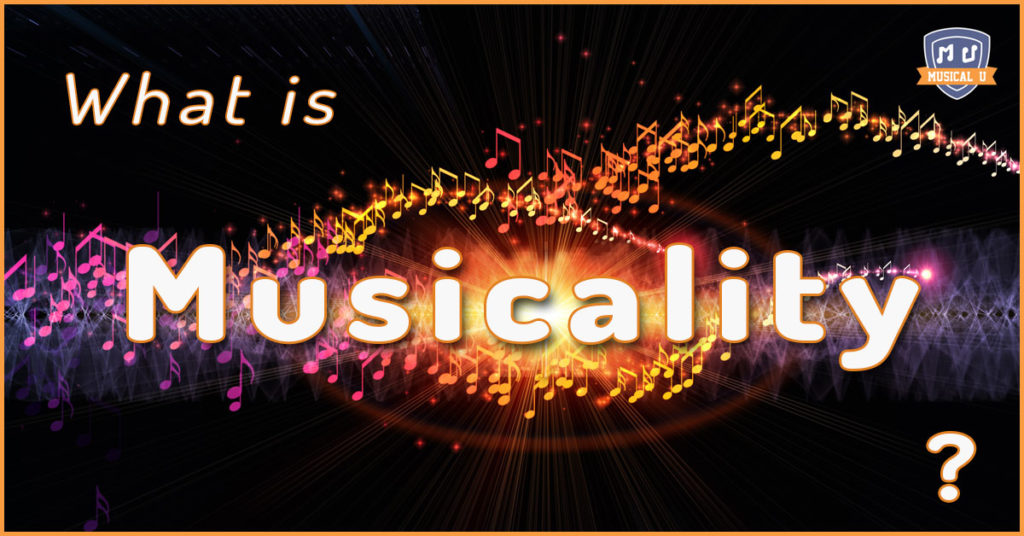We use the word “musicality” a lot here at Musical U. But what exactly does it mean? As musicians and music lovers we all have some instinctive understanding of what musicality is, and perhaps we can even spot it when we see (or hear) it. Do we truly understand the full range of skills and experience bundled up in that simple word though?
Musicality is a very useful catch-all for “being musical”. It encompasses many of the skills we help people to learn at Musical U. Like all catch-all terms though, there is a downside to the convenience. By using this short and simple word we risk overlooking many of the dimensions and subtleties it’s used to represent.
So let’s take this opportunity to explore: what is musicality?
Musicality and Musicianship
Musicality is an informal word. It’s not quite slang, but it’s certainly less formal than the traditional classical music equivalent: musicianship.
Musicianship encompasses a range of skills. Dictionary.com defines it as “knowledge, skill, and artistic sensitivity in performing music.” The Cambridge Dictionary says musicianship is “a person’s skill in playing a musical instrument or singing.”
So essentially: musicianship means “being a musician”. That’s pretty vague.
ABRSM gets a bit more specific, connecting musicianship to audiation:
“Musicianship is a broad concept that covers a complex range of musical abilities… it is loosely defined as the ability to ‘think in sound’. This occurs when a musician is able to produce music which they perceive internally and in the imagination, whether through playing by ear, singing, reading from notation, or through improvisation.”
In his article “What is Musicianship” Michael Kaulkin (on the Musicianship and Composition faculty of the San Francisco Conservatory’s Pre-College Division) agrees that “inner hearing” is key, writing “Musicianship is about training the student not just to be a player of an instrument, but to be a Musician. The best way to do that is to take the instrument away.”
Defining Musicality
So what about “musicality”? Is it different from musicianship?
Wikipedia has a slightly flimsy page, drawing on the Merriam-Webster definition: “Musicality is “sensitivity to, knowledge of, or talent for music” or “the quality or state of being musical”.”
The Oxford Dictionary gets a bit mystical, saying musicality is “Musical talent or sensitivity” giving examples:
“her beautiful, rich tone and innate musicality”
and
“his compositions reveal an exceptional degree of innate musicality”.
If you’ve been following this blog then you know we at Musical U can’t stand the Talent Myth and think “talent” doesn’t compare to practice for becoming a great musician.
So we’re not keen on definitions of musicality which imply it’s a “gift” or something innate rather than learnable.
However, there is something valuable in those talent-based definitions: they capture the ineffable quality of musicality, the fact that it isn’t a simple yes/no quality, nor something you can fully define in a single sentence.
In fact Dr. Chad West who regularly presents on the subject of modern musicianship defines 5 “Big Skills” which contribute to musicality and go way beyond instrument technique or being born talented.
Here at Musical U we like this short and simple definition:
Musicality is a set of “inner skills” which let you freely and confidently express yourself in music.
We’ve unpacked that into a large number of specific skills and explored each of these here on the blog in our “Musicality Means” series and we have a Musicality Status Check for our members to see which areas they want to focus on improving next.
Here (in no particular order) are some of the skills we believe are important parts of musicality:
- Playing by ear
- Singing in tune
- Jamming
- Having good rhythm
- Writing music
- Writing notation
- Improvising a solo
- Talking music
- Understanding Music Theory
- Clapping in time
- Knowing your instrument inside and out
- Tuning your instrument by ear
- Reading notation
- Sight-reading music
- Playing from a lead sheet
- Performing live
- Playing multiple instruments
Let’s look at each of these in turn and see how they contribute to being musical.
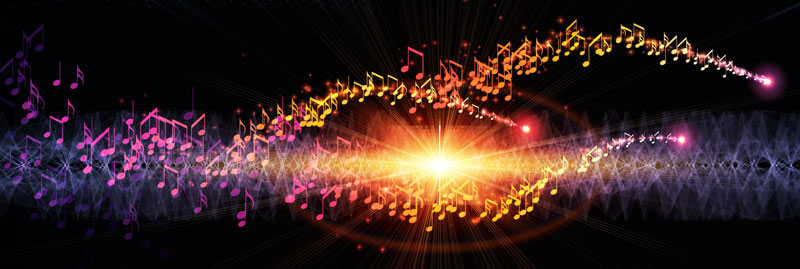
Playing by ear
This is probably the most prominent skill people associate with musicality. When you see a musician who can easily pick up their instrument and play any song or piece of music they’ve just heard (possibly for the first time), without the need for sheet music, a chord chart, or any kind of practice time to learn the piece – now that’s musicality! Right?
This skill can be so impressive (particularly if you don’t know how learnable it actually is) that it is one of the primary causes of people believing that musicality is an innate “gift”.
If you don’t understand how to learn to play by ear, then it can seem like you need a mysterious “talent” to do it. Fortunately, once you learn how to play melodies by ear or how to play chords by ear the mystery dissolves and you realise that like all other aspects of musicality, this is something you can learn for yourself.
→ Learn more about the musicality of playing by ear
Singing in tune
Being able to sing in tune is an important skill for any musician, not just those who consider themselves singers. It might not seem like a prominent part of musicality, but just think about the opposite: can you imagine thinking someone is really musical if they always sing out of tune? Probably not!
You don’t need to have a phenomenal voice to be an excellent musician, but you do need to master the basics like matching pitch and vocal control. This allows you to use your voice as a tool to train your ears and to communicate with other musicians. It’s the instrument you always have with you and so once you learn to sing in tune it’s an easy and natural way to express yourself in music and show your musicality.
Jamming
From the outside, a musical jam session can seem like the pinnacle of musicality. A bunch of musicians each with their own instrument all sit down together without preparation and produce coherent great-sounding music on-the-fly. How do they do it?
Jamming is actually a combination of several different skills, including active listening, having good rhythm, playing by ear and improvising, and talking music. It’s a great representation of the versatile skills covered by “musicality” and joining a jam session can be an effective way to put your own musicality to the test and help you to reach new heights. Plus, it’s simply a lot of fun! Especially if you’ve been struggling in the classical world of learning repertoire in detail and practicing scales to pass exams, learning to jam can bring a new freedom of expression to your music-making that you never knew was missing.
→ Learn more about the musicality of jamming
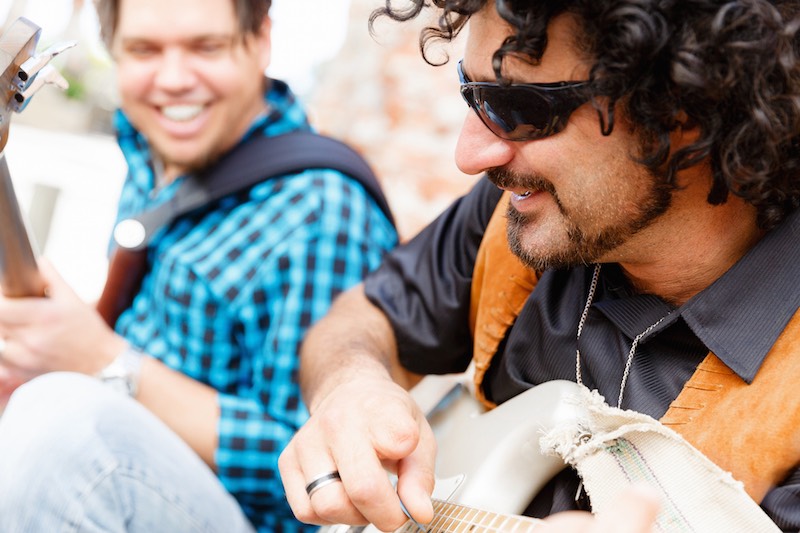
Having good rhythm
Like singing in tune, having a good sense of rhythm is something musicians can take for granted – but you really notice when it’s missing!
There is a basic level of rhythmic ability which all performing musicians must have, and which is normally taught as part of instrument lessons. This includes the true fundamentals like finding the beat and clapping in time (more on that below) but it can also extend to true rhythmic mastery and fine-grained accuracy. This is actually a large part of what sets a “good” musician apart from a “great” one. When we’re shocked by the high degree of musicality displayed by a performer on stage, it’s often the rhythm, whether we realise it or not, that has caused us to be impressed.
To reach basic musicality you need to master rhythm fundamentals, and to truly refine your musicality to a pro level you need to upgrade your sense of rhythm even further.
→ Learn more about the musicality of having good rhythm
Creating music
Once upon a time, composing music went hand-in-hand with being a musician. Any serious performing musician was expected to be fully trained as a composer too. Over the years we’ve lost this association and now divide the world of musicians into those who are “composers” or “song writers” and those who “just play an instrument”.
To feel truly free and confident in music though, it’s vital to be creating your own musical ideas. One way is through improvisation, which we’ll cover below. The less high-pressure way is to sit down and try to compose your own musical creations, whether that’s a simple melody, a whole song, or a fully-fledged orchestral arrangement.
Learning to write music pushes your musicality to new levels in a number of areas and (like jamming) it’s a great showcase of what you can do in music.
→ Learn more about the musicality of writing music
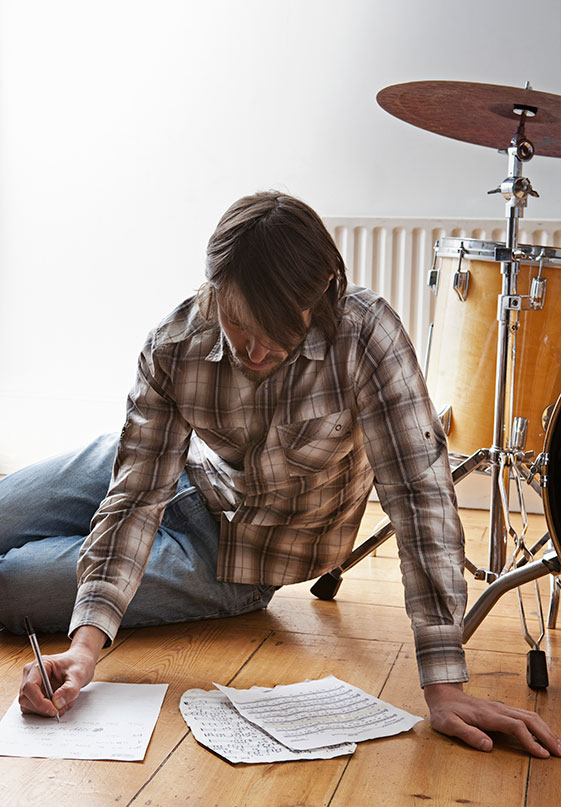
Writing notation
Assuming you’ve started creating music, where does it go? In the modern age it’s so easy to record ourselves performing music, or to grab an interactive app which makes it easy to jot down musical ideas in a simplified visual representation such as guitar tab or a “piano roll” display.
However, there is still great value in learning to write traditional “score” music notation. It gives you a deeper understanding for reading music notation (more on that below) and it’s the most universal written form across musicians of every country and tradition. This makes it an important part of musicality, for your understanding of theory and ability to communicate musical ideas.
Don’t be intimidated! Although musical notation can become complex (which is actually one of its strengths) it can also be very simple and once you’ve learned a few basics you’ll soon be ready to start jotting down your own musical ideas in score notation.
→ Learn more about the musicality of writing notation
Improvising a solo
Another important part of creating your own music is improvisation, meaning you express your own musical ideas without prior planning. Of course that doesn’t mean to say you haven’t prepared! Improvisation is a learned skill, and you can train up the core listening skills you need (closely related to playing by ear) and learn improvisation “vocabulary” to put to use. But the idea is that each improvisation is original and unique, created in the moment.
Of all musical skills, improvisation is perhaps the most intimidating before you start to learn it. Fortunately, learning to improvise doesn’t have to be challenging. You can even start with improvisation games or simple mini-challenges to learn to improvise.
Once you start getting the hang of it, improvisation becomes a fun and powerful way to regularly push the boundaries of your musicality and it’s a particularly effective way to increase your musical confidence.
Talking music
Have you ever listened in to a group of musicians talking and been completely baffled? However experienced you might be in music, if you go outside your genre or normal musical environment it’s easy to quickly get lost in a jungle of terms and phrases which are new and confusing for you.
Learning the “jargon” or “slang” used by musicians is an important aspect of musicality as it allows you to easily understand and communicate with other musicians. Although it’s possible to collaborate musically without spoken words, it’s a lot easier if you are speaking the same language!
An extra benefit is that learning new vocabulary almost always means learning new concepts too, so making the effort to study up on new music jargon extends and improves your musicality by broadening your overall understanding of what’s going on in the music you hear and play.
→ Learn more about the musicality of talking music

Understanding Music Theory
It may not be a favourite topic among musicians, but it’s a vital one: music theory! Although the “talent” definition of musicality might lead you to believe you can be truly musical with zero understanding of theory, this would be incorrect.
Even the greatest self-taught musicians who claim to know no music theory actually do. They may not know the traditional terminology or have taken any formal lessons, but through sheer experience and exposure they have actually trained themselves in all the core concepts covered by the term “music theory”.
Studying music theory directly is a shortcut to that instinctive understanding of how music works.
Although it’s traditionally taught in a dry and boring way, music theory does not need to be so dull! In fact, by combining it with listening skills like we do in our “Ear Expansion” modules here at Musical U, or teaching it in an interesting and engaging way like at DaveConservatoire.org, or relating it directly to pop and rock music like they do at hooktheory.com, it’s possibly to make the learning of music theory just as enjoyable as music itself.
So don’t shy away from it! Music theory can be a fast and fun way to improve your musicality.
Clapping in time
We’ve already covered the importance of having a good sense of rhythm, but there’s one specific rhythm skill that stands out as vital for good musicality: can you find the beat? Can you clap along with it and keep in time?
You only need to go along to a rock concert to see this one in action. If you see 20 people clapping along in time with the band and one person who seems to be in a world of their own with mis-timed claps all over the place, which one are you going to judge as having limited musicality?
The surprising fact is that even quite experienced musicians occasionally have difficulty with clapping in time. They may be great at playing back complex rhythmic patterns on their instrument, and they may even have mastered rhythm notation but ask them to clap along with a pop song, or to keep time while someone nearby is clapping out of time, and they may well struggle!
That can be embarrassing for someone who considers themselves to be musical, and so it’s worth paying attention to this simple but fundamental aspect of musicality.
→ Learn more about the musicality of clapping in time
Knowing your instrument inside and out
Learning to play an instrument is perhaps the most defining characteristic of “being a musician”, and it’s a common trap to fall into, to consider this the only thing you need to do. Of course, as we’ve been exploring, there is much more to musicianship than just instrument technique.
Supposing you’ve already got the hang of playing an instrument. Is that all there is to it? Actually, when it comes to musicality, you need to take it a step further.
Speak to someone who is clearly “very musical” and they won’t just have mastered playing advanced pieces of music on their instrument. They will be able to take advantage of every playing technique the instrument offers, to express their own musical interpretation on each performance. They will be able to tell you about the history of the instrument and the different models available and their pros and cons. In fact they will probably talk your ear off once they get started!
This passion for your instrument is a hallmark of professional-grade musicianship, and that’s why knowing your instrument inside and out is an important part of musicality.
→ Learn more about the musicality of knowing your instrument
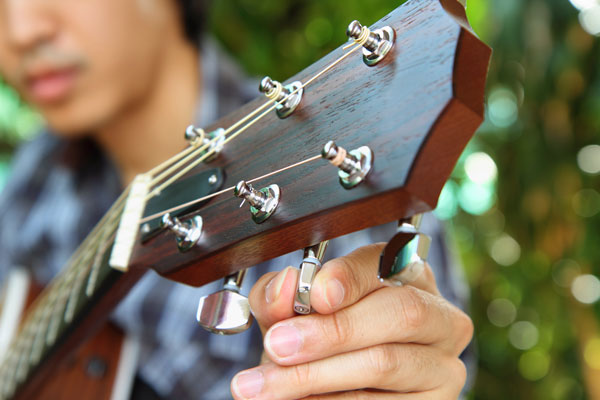
Tuning your instrument by ear
Another skill which is easy to overlook in the modern technology-assisted age, tuning your own instrument by ear is still a valuable skill for a musician. Again, consider the opposite: would you think someone was highly musical if they were completely unable to get their instrument in tune when their digital tuner ran out of batteries or went missing?
You don’t want to be wholly reliant on technology for your music-making and there’s nothing worse than playing out of tune. So take the time to learn how to tune up by ear. It’s a great way to hone your pitch sensitivity and that improves your tuning throughout your musical performance, not just while you’re literally tuning up.
→ Learn more about the musicality of tuning by ear
Reading notation
We’ve already mentioned the valuable universal nature of traditional “score” notation. If you want instant access to a vast library of the music which has moved the world for decades and centuries, there’s nothing which compares to it.
Or is there? Once you’ve mastered playing by ear from recordings you might think that reading from score notation is redundant.
In fact, reading notation is a valuable complement to play-by-ear skills. For example, it allows you to quickly and directly play new repertoire, even without having ever heard it! This is common in the world of jazz where musicians often have to “sit in” (see above re: jamming) and play directly from a lead sheet (see below re: lead sheets!) It’s also very valuable for singers, who may need to sight-sing from written notation in a choir.
Learning to read music also allows you to practice audiation (imagining music in your head) which unlocks extra practice time in your day. You can’t play your trumpet on the train to work, but you can look at sheet music for your next recital and use “mental play” to practice fingerings and work out your performance choices.
There’s a reason that score notation is still being used throughout the music world today despite dating back hundreds of years. It’s simple (honestly!), versatile, and endlessly useful. That makes it a vital skill for modern musicality, just as it was in the age of Beethoven and Bach.
Sight-reading music
Most musicians learn to read music notation slowly and carefully, as they learn to play simple pieces on their instrument. In most situations this is fine. You can gradually take the time to work out the notation, note by note, and then play it on your instrument.
However, there is a higher level of reading notation, which is being able to “sight read” it. This means that you directly play the music from the score, with little or no preparation.
It’s normal to find sight reading challenging, and generally a musician will only be able to sight read music which is a few notches simpler than the music they play in their learned repertoire.
However, by making sight-reading part of your musical training you can develop this very useful ability: to pick up a new piece of music and play it immediately, even if you’ve never heard it before. That’s a pretty impressive demonstration of musicality!
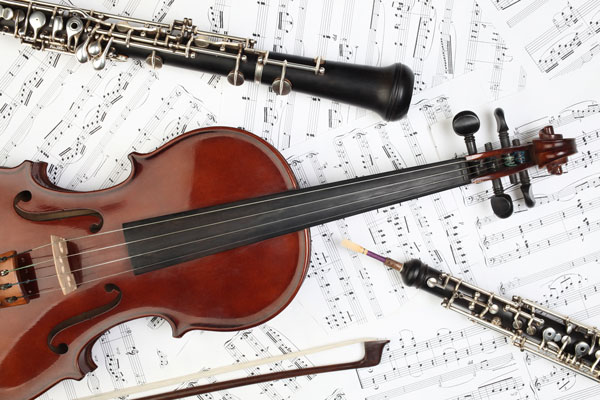
Playing from a lead sheet
A “lead sheet” is a simplified form of written notation, typically providing just the score for the melody, lyrics (if any), and the chord symbols for the harmony. It can allow a whole song to fit on a single page or two.
Lead sheets are most commonly used in jazz music but are frequently found in pop and rock too, since they allow for literally hundreds of songs to be included in the same printed book.
To play directly from a lead sheet requires a combination of musicality skills, including improvisation, music theory understanding and (if performing in a group) jamming.
If you can read score notation and have a basic understanding of music theory then the literal act of reading a lead sheet won’t be too challenging. But you might find that trying to create a compelling performance as you read the lead sheet actually stretches you in new and interesting ways. It’s also a great tool to add to your toolkit, increasing the range of musical opportunities you are prepared to participate in confidently.
→ Learn more about the musicality of playing from a lead sheet
Performing live
It may or may not be one of your musical goals to get up on stage and wow a crowd. Either way it can’t be denied that performing music live, whether to a stadium audience or just to your cat, is a key part of being musical.
It might be playing a new pop song by ear, improvising a rock guitar solo, or carefully performing a piece you’ve practiced a thousand times. However you choose to express yourself musically, learning to do it in a live situation for an audience, where it is framed as a one-off performance to please the listener, rather than a loose play-through for your own enjoyment, is an important skill to develop.
It can be scary, especially when performing something new or when the opportunity is big or exciting. You’ll have to draw on all aspects of your musicality to ensure a great performance.
→ Learn more about the musicality performing live
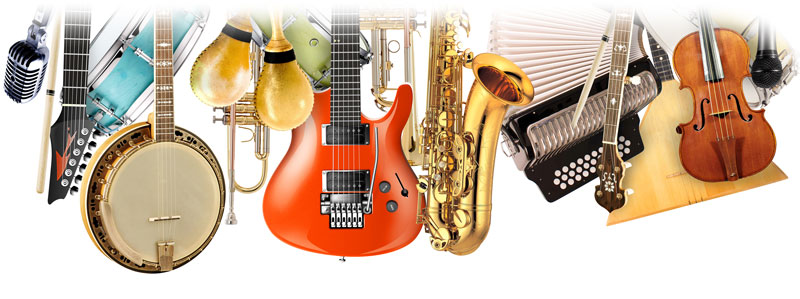
Playing more than one instrument
We’ve already said that musicality means much more than just learning to play an instrument. This is demonstrated clearly by how we associate multi-instrumentalism with musicality.
If we hear that someone plays three instruments we don’t just think they’ve done three times as much music practice as someone who just plays one. We start to imagine that they have some inner ability in music which allows them to learn instruments more easily than others.
This is because there are certain aspects of learning to be a musician which carry across from one instrument to another. Specifically, it’s all those “inner skills” we referred to in our definition of musicality at the beginning.
All of your listening skills, including those which power playing by ear, improvising and creating your own music, all of your performance skills, including playing from a lead sheet, jamming, and musical confidence, and all of your knowledge and understanding, including knowing how to “talk music” and understanding the theory, can be transferred from one instrument to the next. This means that although the physical movements for a new instrument may all be new to you, learning a second and then a third will come much faster than the first. In fact, the more you’ve developed your musicality, the easier it will all be.
Learning multiple instruments isn’t just about impressing people with how musical you are. It’s a great way to:
- Learn theory in a more versatile way
- Develop more robust and reliable listening skills
- Be able to collaborate in more varied situations
- Explore new genres and traditions of music
- Improve your musicality more fully and faster
You might worry that taking up a second (or third or fourth!) instrument will slow down your progress on your main instrument, but many musicians find the opposite is true. Because it stretches you in new ways while honing your inner musicality, it may actually help you to become a more proficient and expressive musician on your main instrument as well.
What does Musicality mean to you?
Using a catch-all word like “musicality” is helpful because it’s simple and conveys roughly the right meaning. As we’ve discussed, the main disadvantage is that it oversimplifies and can cause us to overlook important and interesting aspects of the subject.
But there is another advantage: its generality makes it adaptable.
This means that your musicality can be different from somebody else’s. As all the examples above prove, there are a huge variety of ways to “be musical” and each musician has a different combination of strengths and weaknesses.
Each weakness is a new learning opportunity, and so your current musicality and the future of your musicality training are both 100% personal to you.
You can use the list above as a checklist to assess your own musicality and identify areas you’d like to improve on. Some probably stood out to you and made you think “Wow, I’d love to be able to do that”. You can!
Everything we’ve covered here is a learnable skill, and many of them much easier to learn than you might expect, especially if you have access to high quality training materials and expert support and guidance.
Whatever your next steps might be, I hope you are now seeing musicality in a new light: as a collection of exciting musical skills, all of which are available to you to learn, and which can be combined in your own unique way to define your own musicality.

